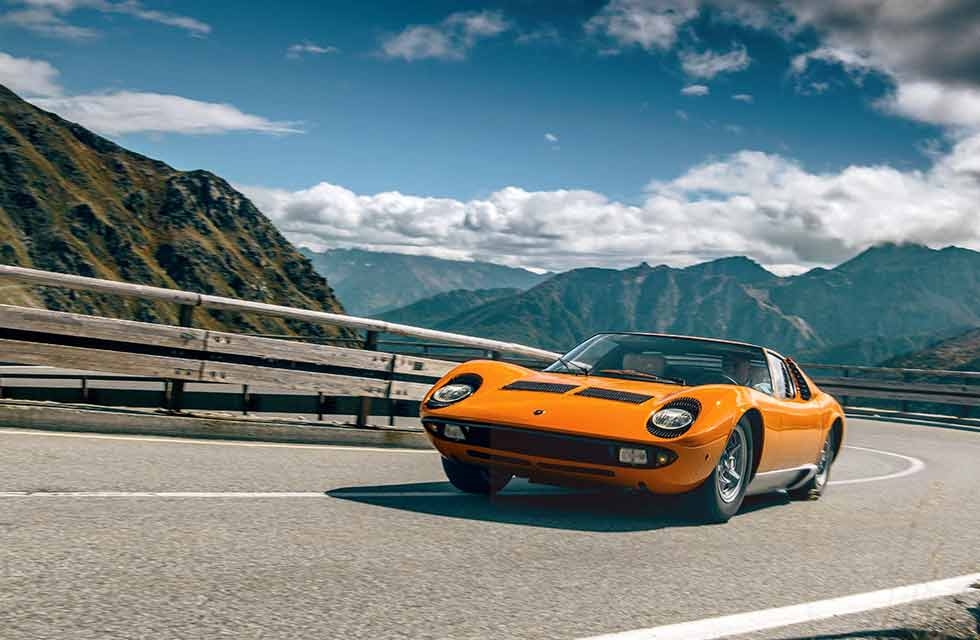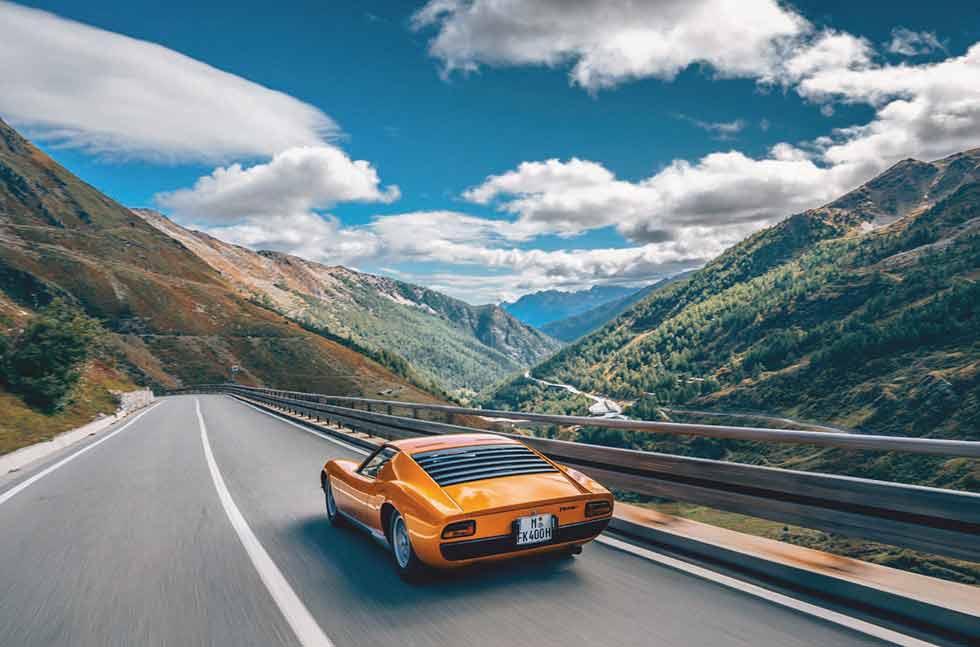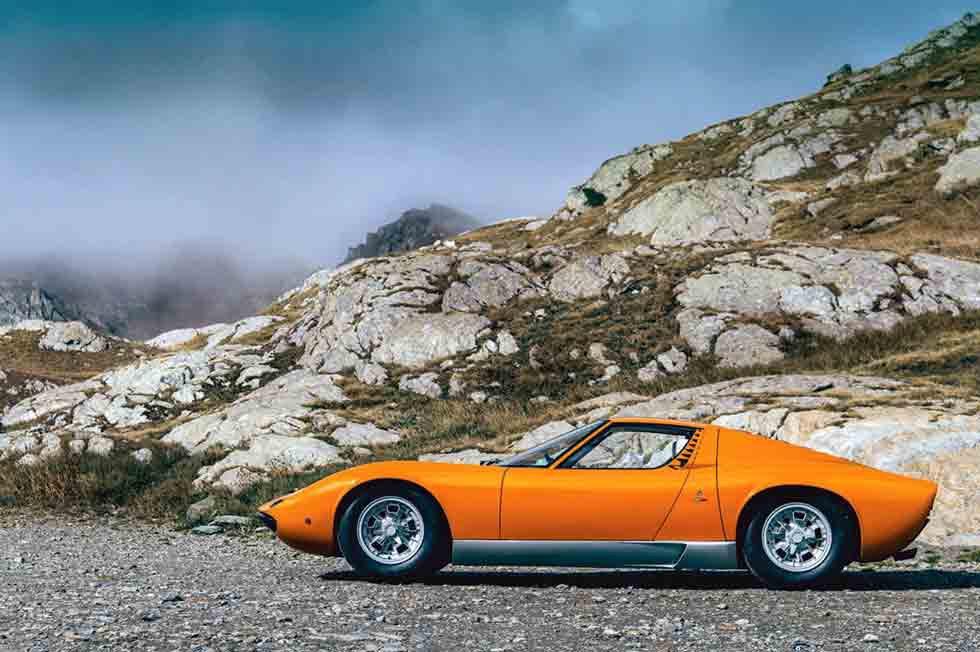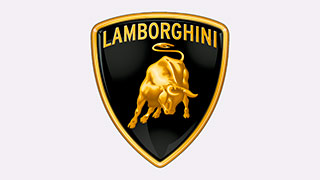
Miura gets back on set 50 years on, The Italian Job Lamborghini returns to the roads that made it famous. That car, on that road: The Italian Job relived with the very Lamborghini Miura that starred in the opening sequence of the famous film. Words Alastair Clements. Photography Olgun Kordal/Paramount Pictures/David Wynn-Jones.
PASS MASTER – ITALIAN JOB RELOADED!
MIURA MOVIE STAR Lamborghini exclusive Big-screen icon returns to the Alps
‘The controls are heavy and demand decisive movements, but you soon settle in, flowing with this sinuous, scenic route’
This can’t be happening. We’ve just covered the 305m of the Dardanelli Viaduct in a flash of orange rage and are already negotiating the first hairpin bends of the Colle de Gran San Bernardo in a Rosso Miura Lamborghini. This can’t be happening… Can it? After all, that car met its end impaled on the front of a Caterpillar D7171A bulldozer, right? Wrong. Of course wrong, because as we all now know, the Lambo that met an ignominious fate just minutes into the 1969 crime caper The Italian Job was an engineless shell.

Until earlier this year, however, the true fate of the car driven by heist planner Roger Beckerman (Rossano Brazzi) was a source of speculation. No more: the Miura P400 we’re in today has been certified by Lamborghini’s Polo Storico wing as the film-star car, and this is thought to be the first time it has returned to the Great St Bernard Pass since production of the film. The same goes for its driver, Enzo Moruzzi, Lamborghini’s man on the scene and pilot of the Miura in all but the in-car images of Brazzi wearing those famous Renauld Mustang sunglasses and lighting the obligatory cigarette – shot via a camera mounted on the door.
‘This is surely the best view in motoring, the tumbling peaks of the bonnet forming a curvaceous rendering of the mountains above’
“The last time I drove this car was 29 June 1968,” the septuagenarian smiles. “I was 26 then. I had left on Thursday, on Friday we prepared the car with the cameras, we filmed all day Saturday, then on Sunday morning I drove back to Sant’Agata.” Wearing a Lamborghini-branded red v-neck sweater beneath a long black leather coat, Moruzzi is as dapper as he is animated: a ball of nervous energy, eyes twinkling and hands full of gestures in the Italian tradition. Ah yes, the hands. The way they manipulate the wheel is uncannily familiar: deliberate, respectful, caressing the leather rim and never crossing despite the acute corners we’re tackling.

And then it dawns: they’re the hands we see in the close-up driving shots in the film. “The cameraman was in the passenger seat and shouting at me to sit as far back as possible,” Moruzzi explains. “When the movie came out in 1969 I was engaged and I took my fiancée to see the film. She didn’t know I was in it, but when she saw the opening sequence she turned to me and exclaimed, ‘Those are your hands!’”
The Miura’s role lasted barely four minutes – much of that overlaid with the titles – before its abrupt end at the base of a gorge, commemorated by a wreath from Mafia boss Altabani (Raf Vallone). Yet it was quite a cameo. Even now, I defy anyone to drive an Alpine pass and not to picture themselves in a Miura, or to hum the first few bars of Matt Monro’s haunting On Days Like These. The combination of that dreamy song, written for the sequence by soundtrack maestro Quincy Jones, and the fantasy imagery is what make its ultimate demise so shocking, with director Peter Collinson setting out the movie’s stall as a cut above the heist-flick norm.
‘The howl of the quad-cam V12 is all-consuming: not the highly-strung song of a contemporary Ferrari, but something more feral’
The story of the car itself is almost as familiar as that of the film, but it’s worth reiterating just to reinforce what an incredible achievement the Lamborghini was. Inspired by Ferruccio, the eponymous tractor magnate who decided to go out and build better than Ferrari, engineered by Gianpaolo Dallara and engined by Giotto Bizzarrini. But it was the hook-up with Bertone, and particularly young stylist Marcello Gandini, that led to its breathtaking shape and sired a dynasty of dramatic supercars.

Shown as a chassis at Turin in 1965, a year later it was at Geneva wearing its jaw-dropping new clothes and by early 1967 cars were rolling out of the factory at Sant’Agata Bolognese. Such was the reaction to this 170mph (claimed – 163 is probably more realistic) roadgoing rocketship, the projected 20 cars per year turned into 108 in the first 12 months, yet to spot one on the road remained a rare treat for most enthusiasts. The same is true today, even if its fleeting but fundamental performance on the silver screen has helped to build the legend. The majority of Fiat Pandas we pass as we follow the road up from Saint Rhémy, where the bulk of the shooting took place, are locals – many of whom have never even heard of the film. But one keen driver in a British-registered Jaguar XJ40 makes a comedy double-take as the Miura roars past.
Although he worked for Lamborghini for nearly 40 years – from July 1966 to July 2004 – it’s been a while since Moruzzi drove any Miura, and he is initially cautious, cursing the cold gearbox and double-declutching as he feels his way back into the car. But as the oil warms up, so Moruzzi gets back into the groove, and the revs climb with the road. “Now it sounds how I remember,” he laughs as the Miura begins to sing, then pops, spits and fizzes on the overrun.
Cinematic landmarks appear – such as the old hospice, now closed for the winter – further adding to what is surely the best view in the automotive world, the tumbling peaks of the bonnet forming a curvaceous rendering of the mountains above. The scenery has changed little, though the road now has rather more safety barriers and we’re shooting several months later, so there’s no snow on the ground. In a few weeks’ time, however, the Pass will be impassable.

In between coaxing the meaty gearlever through the six-fingered gate – refinished in gold during the restoration to match the original build sheet – Moruzzi recalls how he made the shift from managing VIP clients to appearing on film. “As custom and car registration manager I was the link between the admin and commercial offices,” he explains. “Commercial director Ubaldo Sgarzi sent the orders to Bertone, and when cars came back to the factory my job was to write down the colour combination, engine and chassis numbers, then get them registered. I must have done 6-7000 cars in my career.
“The Paramount Pictures producer came to Sant’Agata in around March/April of 1968 and said he was looking for a car to crash, so Sgarzi went to the Reparto Assistenza [service department] and found a crashed Miura in Rosso Miura already without its chassis plates. They took out the engine and the original owner bought a new Miura with the same engine and chassis number to avoid paying import duties!
“When filming time came in June 1968, we needed a car to match. This one happened to be on the production line and in the correct colour. Although it is officially called ‘Rosso’ it’s really orange – Mr Lamborghini wanted a red colour, but it had to be different from Ferrari red. We took the car from the line, the test driver did the procedural 100km, then I put on Prova [test] plates and drove it from Bologna to Aosta, more than 400km. I was careful because the car was going to be delivered as new – we disconnected the odometer to avoid the extra mileage, which is why the speedometer needle doesn’t move in the film.” Looking at behind-the-scenes images, it’s remarkable that the car wasn’t damaged by the Heath Robinson collection of planks, ropes and chains used for the camera rigs.
“I also asked the factory to change the seats because the white ones would get dirty,” recalls Moruzzi, “but you can see the white headrests in the film.” This tiny point would later prove crucial in confirming the car’s identity. Like most early Miuras, chassis 3586 was specified with black vinyl, but from car number 165 leather became available as an option, and the order was uprated to white leather (Bianco Pelle) – the only one of the three Rosso Miura cars built in June 1968 to be so specified.

Its cinematic role over, 3586 was delivered to dealer Zani in Rome on 2 July 1968. Seven Italian owners later, in 2013 itwent to France, when rumours surfaced about its famous past after dealer Eric Broutin spotted the unusual colour combination. He and subsequent UK owners Keith Ashworth and IainTyrrell began to collate a file of evidence, which formed the basis of the more recent – and conclusive – research since the car moved to Liechtenstein and current keeper Fritz Kaiser in late 2018.
Quite apart from its historical significance, that white leather really lifts the otherwise unremittingly black cabin. Ahead of the wheel are a huge rev-counter and speedometer, with six ancillary dials in a central fascia that turns to address the driver. As the black mouth of a tunnel approaches, Moruzzi scrabbles for the bank of switches in the roof, flicking on the Miura’s headlights. It’s impossible not to flinch as we enter, eyes peeled for a rogue bulldozer from the construction site down the valley – even though we both know that the fated tunnel in the film is a good 40 minutes’ drive away in La Thuile.
We burst out the other end, breathe again, and after a few more switchbacks the road opens up at 8000ft, where a discreet barrier marks the Swiss border. Here we stop, just as Moruzzi did in 1968: “We couldn’t enter Switzerland because of those Prova plates [taped over for filming].”
While the photographer is inspired by the misty backdrop, we once more take in the beauty of the Miura. Lifting the huge front and rear clams reveals a chassis extensively drilled for lightness. “The father of the Miura was really Dallara,” Moruzzi reflects, full of respect for the gifted engineer. Certainly getting the car unnaturally low was quite an achievement, as was the packaging to keep it so compact – largely thanks to the V12 being mounted transversely over the gearbox, Mini-style, with a shared sump.
Later S and SV variants with more power, a wider rear track, fatter tyres and bigger brakes are preferred by enthusiast drivers, but for sheer purity of line the original P400 is impossible to match. From its famous headlamp ‘eyelashes’ to its lithe, pouncing shape, it’s the finest design to emerge from Gandini’s prolific pen.
Unsurprisingly, it instantly caught the eye of casting directors, and the Miura was soon in demand on set. For Moruzzi it made a fascinating sideline: “With any Lamborghini you see in a film from the ’60s and ’70s, I am the man driving. I became friends with all of the actors – I shared a hotel in Aosta with Brazzi and Valone, and they pushed for me to be paid as an actor because I was in the movie so much. I remember another film in which a man gave his mistress a Miura, but she was played by Mariangela Melato and she couldn’t drive it – so I had to wear a dress and a blonde wig and drive around Rome! After this, the factory sent me to lots of films with Miuras and Espadas – it was great fun.”
The Italian Job was and always will be a Mini adventure, but for many the opening sequence had the most impact – not least because so few people had even seen a Lamborghini 50 years ago. It’s easy to see why the filmmakers chose a Miura rather than the ‘silver Iso Grifo’ in Troy Kennedy Martin’s original screenplay: this car must have looked more flying saucer than mere road car in the ’60s. Five decades on, it still has the capacity to stop you in your tracks.
Thanks to Fritz Kaiser; Lamborghini Polo Storico (www.lamborghini.com); Porter Press. The Italian Job and all related elements copyright © 2019 Paramount Pictures, all rights reserved
Pop-ups rise to reclined position to illuminate the tunnels. Below, l-r: Giotto Bizzarrini’s magnificent V12 provides the soul of the Miura; movie still captures dramatic end for Beckerman; glorious Alpine scenery near Swiss border.
Moruzzi was tasked with ensuring the Lamborghini escaped damage – not easy with bulky camera rigs for action shots.
White leather lifts sombre cabin; the view ahead is dominated by main dials – speedo was disconnected for filming to avoid adding miles. Top: Clements lives out a childhood fantasy.
Distinctive louvres in place of glass rear screen would become a Miura signature, but they were a practical solution to the challenge of cooling the V12 while protecting it from the rain.
Clever packaging of the V12 permits compact dimensions. Below, l-r: back on the St Bernard Pass; Enzo Moruzzi today with Prova plate; director Peter Collinson (leaning on car) oversees Brazzi close-ups. Left: Moruzzi (on right) watches on as the crew prepares Miura.
RESTORING THE LEGEND
The whereabouts of The Italian Job Miura have long been rumoured, but it was only when the car came into the possession of one-time Olympian, former chairman of the Red Bull Sauber Petronas F1 team and founder of the Classic Car Trust (classiccartrust.com) Fritz Kaiser that its provenance was confirmed.
“I collect iconic ’50s and ’60s sports cars,” says Kaiser. “I had a Cisitalia 202 as a cornerstone at the beginning of the collection, and at the end I wanted a Miura. I began searching for one four years ago and looked at 20-25 cars, but wanted one with important history – then I saw this. The dealer claimed it was The Italian Job car but couldn’t prove it. I did enough pre-purchase homework to feel confident and bought it, but didn’t think it would take a year to finish the job!
“The key people in this process were Antonio Ghini and Corrado Lopresto. Antonio introduced me to Enzo Moruzzi, who gave us a living testimony to go with the evidence Corrado found in the Lamborghini archives at Polo Storico. The seats were always the centre of the discussions: there is a handwritten note from Moruzzi saying ‘put the seats back in’ – and this was the only car in that period finished in that specification.”
Lamborghini went through the case with a fine-tooth comb before the official confirmation was issued in March 2019, and Kaiser embarked on a sensitive restoration: “In collaboration with Polo Storico we had to decide the correct way to restore the car. It would have been wrong to make everything new. I wanted to retain all of the original elements of the car – and here I could trust Corrado, he is passionate about detail.”
The chassis, body and drivetrain were rebuilt, but the patina of the all-important interior was carefully preserved. Since completion, and despite the car’s value (estimated to be three times the €1m a top P400 would usually fetch), Kaiser has driven the Miura on the road as well as attending key events worldwide: “I enjoyed taking it to Pebble Beach – it was great to see how many people knew and loved the car. To me its value is not the money, it is its importance in the history of Lamborghini – this is the car that made the company famous. It’s fun, it’s beautiful, it’s wonderful to drive and I’m proud to own it.”
From top: body renovation at Lamborghini Polo Storico; Lopresto (right) delves into the archives at Sant’Agata ahead of supervising the rebuild; meticulous care was taken to preserve seats; owner Kaiser with completed car.
ON A DAY LIKE THIS…
Enzo Moruzzi is the perfect size for the Miura. I am not – nor is anyone the wrong side of 6ft tall – but it’s well worth the effort of getting in and the discomfort once you are there, with knees around your ears and head brushing the cant rail.
The lengthy whirr of the starter is followed by a reluctant catch – not too much throttle, the bank of four triple-choke downdraught Webers behind your ears have a reputation for spontaneous combustion – before the 3929cc 60º V12 grumbles into life. From cold it’s recalcitrant, grumpy, emulating the bull for which it was named, the first low-speed forays a blend of transmission whine, cam-chain chatter and exhaust waffle. The controls are heavy, the gearlever, clutch and even the throttle requiring decisive movements, but it’s a car you soon settle into, flowing with this sinuous, scenic route – albeit always painfully aware of its value.
But to not open it up would be an unrepeatable opportunity missed, and once that quad-cam V12 passes 3000rpm its howl becomes all consuming: not the highly-strung song of a contemporary Ferrari, but something more feral, matching the animal character of this underdog that became the pioneer of a new genre. There’s no redline for the 10,000rpm rev counter but we’re keeping to a conservative 6000 today, 1000rpm short of its 350bhp power peak, and, with a sheer drop to one side, a rock face to the other, we won’t be troubling the upper reaches of the 320kph speedo either.
Begin to push it a little into the corners and the limitations of this earliest of supercars reveal themselves. The Girling disc brakes feel weak, while the combination of the flexible chassis (stiffened with thicker metal on later cars), the narrow rear track and the engine mounted high over the transmission means that you’re always conscious of the car’s mass shifting over the relatively slender 215/70 VR15 Pirelli Cinturatos that wrap those gorgeous Campagnolo magnesium alloys.
But the double-wishbone suspension is supple and the steering is a joy. The flat, three-spoke wheel with its distinctive drilled spokes moves fluidly in your hands, the rack responding faithfully to your inputs and smoothly returning to the straight-ahead as the corner opens and you can wind out that flexible engine to drown out Matt Munro’s incessant earworm just one more time.






